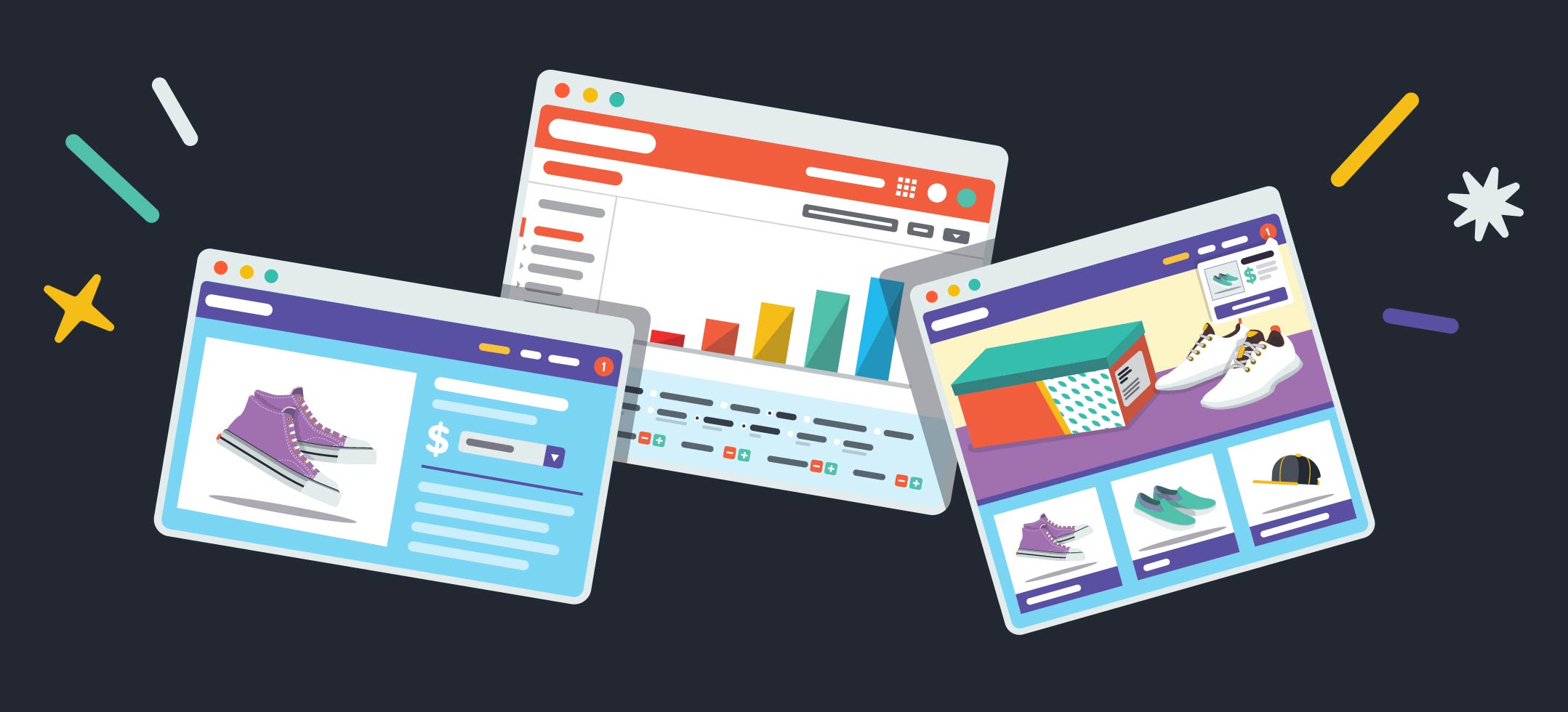
The Fast Guide to Optimizing Your Online Store
Worried your online store isn’t performing as well as it could (or should) be?
It’s probably time to optimize your online store. By doing so, you’ll make it a better tool that converts new online customers and turns them into repeat buyers.
The warning signs that indicate it’s time to optimize are subtle; you might even feel like your online store is doing well. Be on the lookout for these red-flag indicators:
- Your Website Traffic Plateaus or is on the Decline: Any business has up and down months of course, but if you see your average monthly traffic over three to six months has either stayed flat or gone down (especially after seeing consistent growth), that’s a sign that you need to make some changes.
- You See an Uptick in Abandoned Carts: Cart abandonment is the plague of ecommerce. Climbing cart abandonment rates are a sign that you should rethink your checkout experience and make it easier for your customers to complete their purchases.
- You Have a Lackluster Customer Retention Rate: Repeat customers convert easier, spend more money, and refer more people to your business than first-time buyers. You’ll want to make some changes if you struggle to bring people back for a second purchase.
Don’t be Content with the Status Quo for Your Online Store
Sticking with the status quo for your online store means you’ll be left behind as the world of ecommerce booms.
The pandemic has caused a dramatic shift toward ecommerce: In fact, by 2023, ecommerce is projected to make up 22% of all retail sales around the world (up from just 14% in 2019).
With growth that dramatic, we can expect that ecommerce will evolve quickly—but will you be ready to grow and evolve with it? Optimizing your online store for what shoppers want today will help you prepare for the next phase of growth.
If you decide to stick with what you already have, you’ll miss out on:
- Checkout innovations that make it easier for customers to buy from you
- New developments in design that make your site more appealing to customers
- Accessibility advancements to make your store easier to navigate for more people
- New ways to attract and interact with customers both before and after a sale
As an ecommerce store owner, your sales growth potential over the next few years is massive. But as more people recognize this, more online stores will pop up (and that means more competition). There are already 7.1 million online stores around the world—with more opening every day.
Optimization isn’t optional if you want to keep your edge, but figuring out where to start can be difficult. That’s why we’ve put together some of the top online store optimization strategies so you can get ahead of the curve.
Warning Sign #1: You Need People to Buy What They Put in Their Carts
Abandoned carts are the bane of ecommerce. They happen when a customer adds a product to their online shopping cart then leaves the website without purchasing it.
The top five preventable reasons people abandon their purchases are:
- High shipping costs
- Broken discount codes
- Long shipping times
- Having to re-enter credit card information
- Having to re-enter shipping information
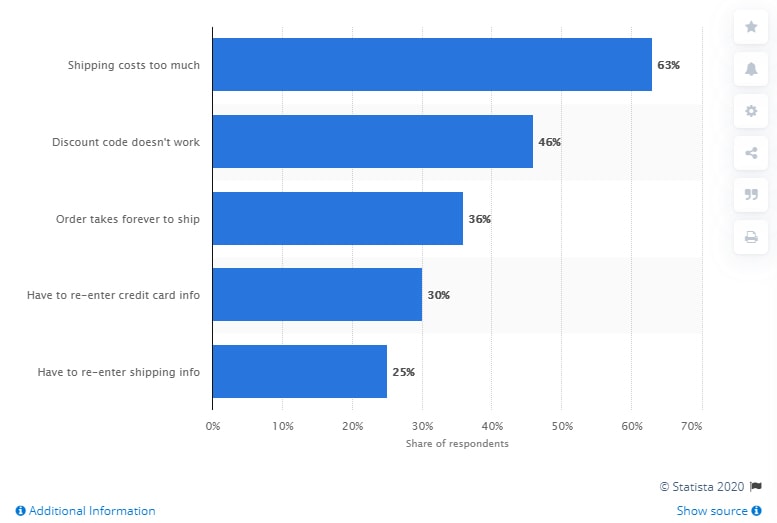
(Source)
While most shoppers abandon their carts because they’re comparing prices or shopping around, others leave for reasons you can prevent by optimizing your online store.
Don’t feel too bad, though: These conversion killers plague every online store. In March 2020, consumers abandoned 88% of all online orders—that’s a lot of almost-sales left on the table.
The good news: Finding ways to reduce your abandoned cart rate even just slightly will have a major impact on your bottom line. Here’s what you can do to optimize.
6 Ways to Turn Abandoned Carts Into Conversions
1. Don’t require an account & let customers check out quickly
The best way to cut down on abandoned carts is to skip the cart altogether. The simpler your checkout experience, the more likely people will be to complete it. Forcing people to create an account adds unnecessary complexity to the process.
Until recently, Amazon had the market cornered for product page checkouts for ecommerce stores—smaller online stores didn’t have any options to implement this resource. Fortunately, a new tool called Fast Checkout makes it possible for shoppers to check out with just one click.
Plus, you can install the Fast Checkout button anywhere on your online store—including product pages, making checkout fast and frictionless for shoppers since they can skip the shopping cart checkout stage completely.
Your customers only have to insert their usual billing information (name, shipping address, payment details, etc.) once—not per store, but once for all time. Fast stores it securely from there, allowing the customer to checkout with one click on any website that has Fast Checkout installed—without having to go to a cart page and fresh checkout process each transaction.
That means if a buyer already has enabled Fast checkout, they never have to fill out any checkout details to complete a purchase from your online store.
2. Make it easy to save carts
Customers may want to leave your website but come back to finish checking out later. You should make it as easy as possible for them to complete that order when they do come back.
Saving the items they have in their cart will make it effortless when they come back to your site and see they haven’t checked out yet.
3. Show shipping costs and other fees up front
No one likes getting to a checkout page expecting one total, only to be blindsided by the cost of shipping, taxes, and fees. A survey of cart abandoners from Baymard found that 50% left because the extra costs associated with an order were too high.
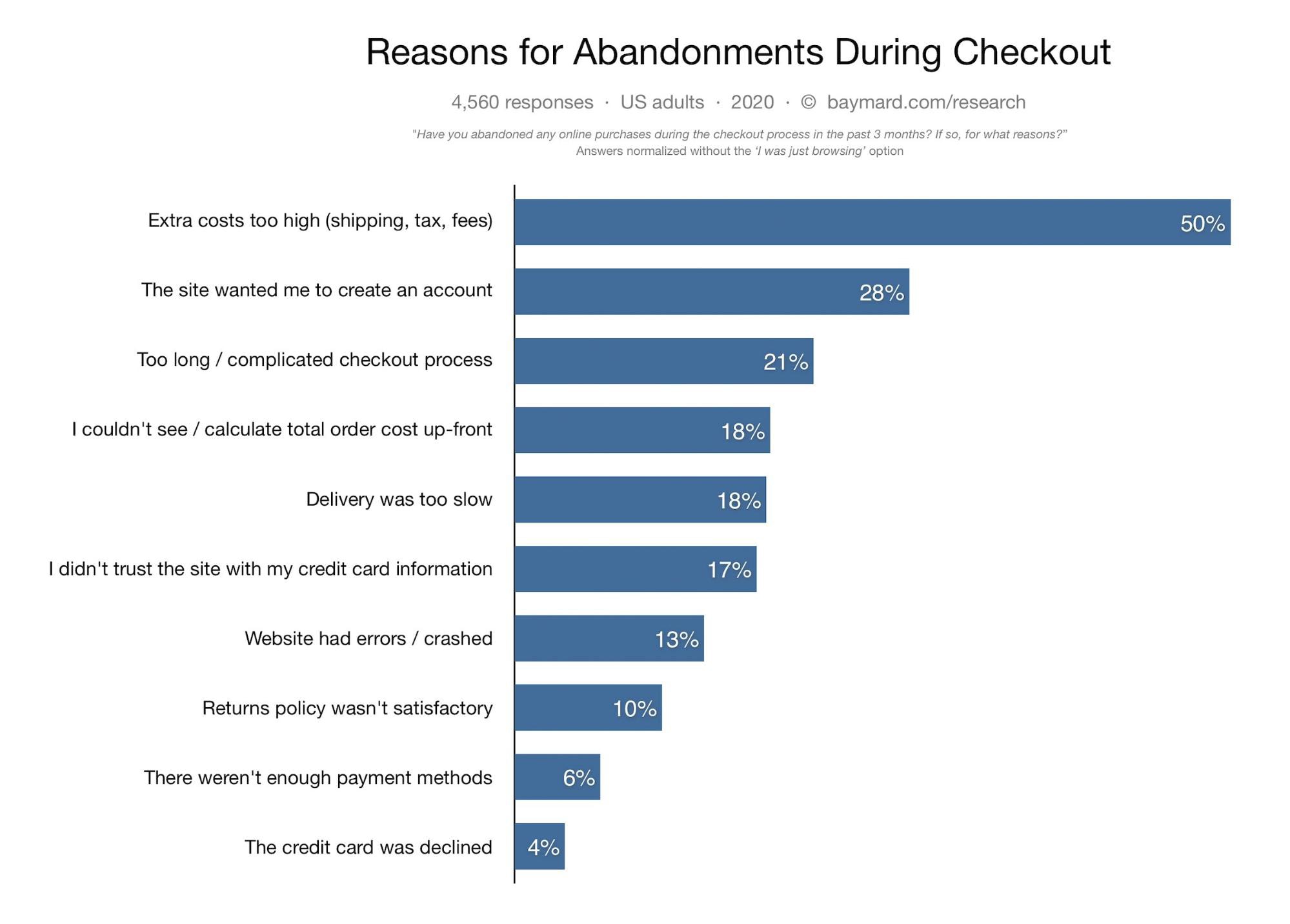
(Source)
While you won’t be able to eliminate these costs completely, you can limit the surprises by showing things like shipping and tax estimates on product pages and within the cart itself so your customers know exactly how much they’ll have to pay for their order.
4. Make cart abandoners think twice with an exit-intent popup
Exit-intent popups follow the customer’s mouse movements to determine when they’re about to leave a page. You can use this tactic to make a would-be cart abandoner pause and consider the items left in their cart one last time.
If a simple reminder isn’t enough, you can entice them to buy (and talk them out of shopping for a better price) with an offer—discounts and free shipping are two popular options.
5. Build trust on the checkout page
A Baymard survey of over 4,500 online shoppers discovered that 17% of people have left items in an online cart within the last three months because they didn’t trust the store with their credit card information.
You should do everything you can to secure your checkout process and assure your customers that it is, in fact, safe to use. Seals and security badges go a long way to build trust at checkout.
Which ones make customers feel the safest?
The same survey found these to be the most trusted badges:
- Norton Secured: 35.4%
- Google Trusted Store: 22.2%
- BBB Accredited Business: 15.2%
- McAfee Secure: 12.3%
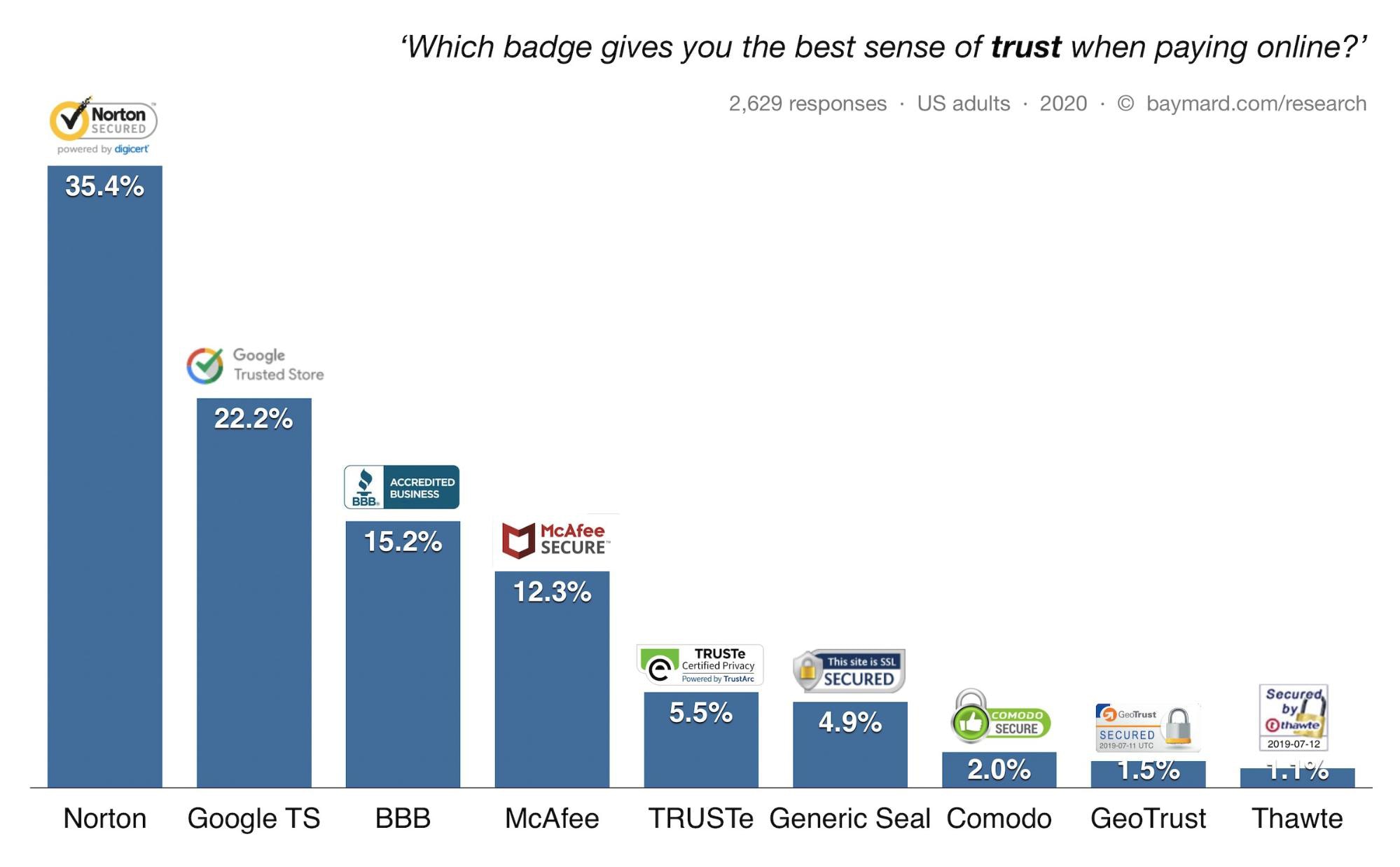
(Source)
6. Use retargeting to close the deal
After someone abandons their cart, they have an 8% chance of coming back to finish the purchase without you having to coax them into it. But retargeting those cart abandoners increases the close rate to 26%.
Social media sites like Facebook and Instagram are powerful platforms for reminding shoppers that they should come back and buy that item they picked out. You can also use display ads, Google search ads, and email remarketing to re-engage your renegade customers.
Warning Sign #2: You Need More Visitors—Who Might Actually Buy Something
Have you hit the brick wall of online traffic growth? Maybe you’ve been cruising along for a few months watching your reports on new site visitors move steadily up and to the right.
Then, all of the sudden, your monthly growth comes to a screeching halt (and maybe even starts to go down).
This online traffic plateau caps your growth potential, but it’s also a sign that you have room to improve your ecommerce site.
The question is: How? Let’s look at seven ways you can fix this issue.
7 Methods to Attract More Customers to Your Online Store
1. Update your online store’s homepage design
Your homepage is your first impression for new customers. It should give them a glimpse of what they can expect from you and your products. People come to your online store with certain expectations—but those expectations change over time.
If it’s been a few years since you updated your homepage, it’s time to bring it back up to date with modern design and simplified navigation. If you need some inspiration, check out these 50 examples of fantastic homepages.
2. Get to know your customers
Who shops at your store and why?
How you answer that will help you hone how you talk about your products and get them in front of new customers. Small touchpoints with recent customers can give you valuable insights into what people are looking for and how you can best help them.
Here are some ideas for learning more about your customers:
- Conduct a customer survey
- Ask post-purchase questions like, “How did you hear about us?”
- Interview a few recent customers
- Monitor your social media mentions
3. Nail your product details
Product details sell your products to two audiences—shoppers and search engines. Do you share your product details in a way that’s easy to read and that’s optimized based on relevant keywords your customers will be searching related to your products?
Product details should appeal to your customers’ desires, answer their questions, and anticipate their fears. If yours don’t, it’s time to optimize. This step can get your products in front of more shoppers and break down the barriers that keep them from buying from you.
If you’re not sure how to tackle this, hire a professional copywriter who has a track record of success and positive results with writing sales-oriented product page copy.
4. Update your product photos
Ecommerce limits a customer’s ability to use all of their senses when deciding to buy your products. Instead, they rely only on how your product looks on your website, making high-quality product photos (and videos) essential for converting more online sales.
Your product photos should be clear, bright, and professional. You can follow this guide to take them yourself or hire a professional photographer who can take this off your plate.
5. Encourage customers to leave positive reviews
Shoppers want to know what other people think about your product before making a decision, making product reviews a critical tool for attracting new customers and boosting sales. Just displaying product reviews can boost your conversion rate by 270%: It’s a tried and trusted form of social proof.
Ask for honest feedback from your customers with follow up emails to help boost your product reviews and make it easy for them to leave reviews.
If your customer reviews are lagging, incentivize customers to provide them with discounts or special offers that give that extra nudge.
6. Invest in content marketing
Content marketing uses things like blog posts, videos, podcasts, etc. to attract people to your ecommerce store. Investing in content marketing is a long-term growth strategy—you won’t see a ton of new site visitors overnight—but it will eventually:
- Boost your search rankings
- Give people more chances to find your store
- Build trust with your customers
- Show that you understand and want to help
Content is often a major undertaking, but with the help of content strategists, skilled freelance writers, and some onboarding materials for your content marketing team, you can start making your online store a hub for top-quality materials within your niche (and win more organic clicks through SEO at the same time).
7. Increase your online store’s page load speed
How fast your store loads will directly affect how many people stick around to see what you’re selling. People are impatient, especially while online shopping. The chance that someone will bounce from your site goes up by 90% if your page takes more than five seconds to load.
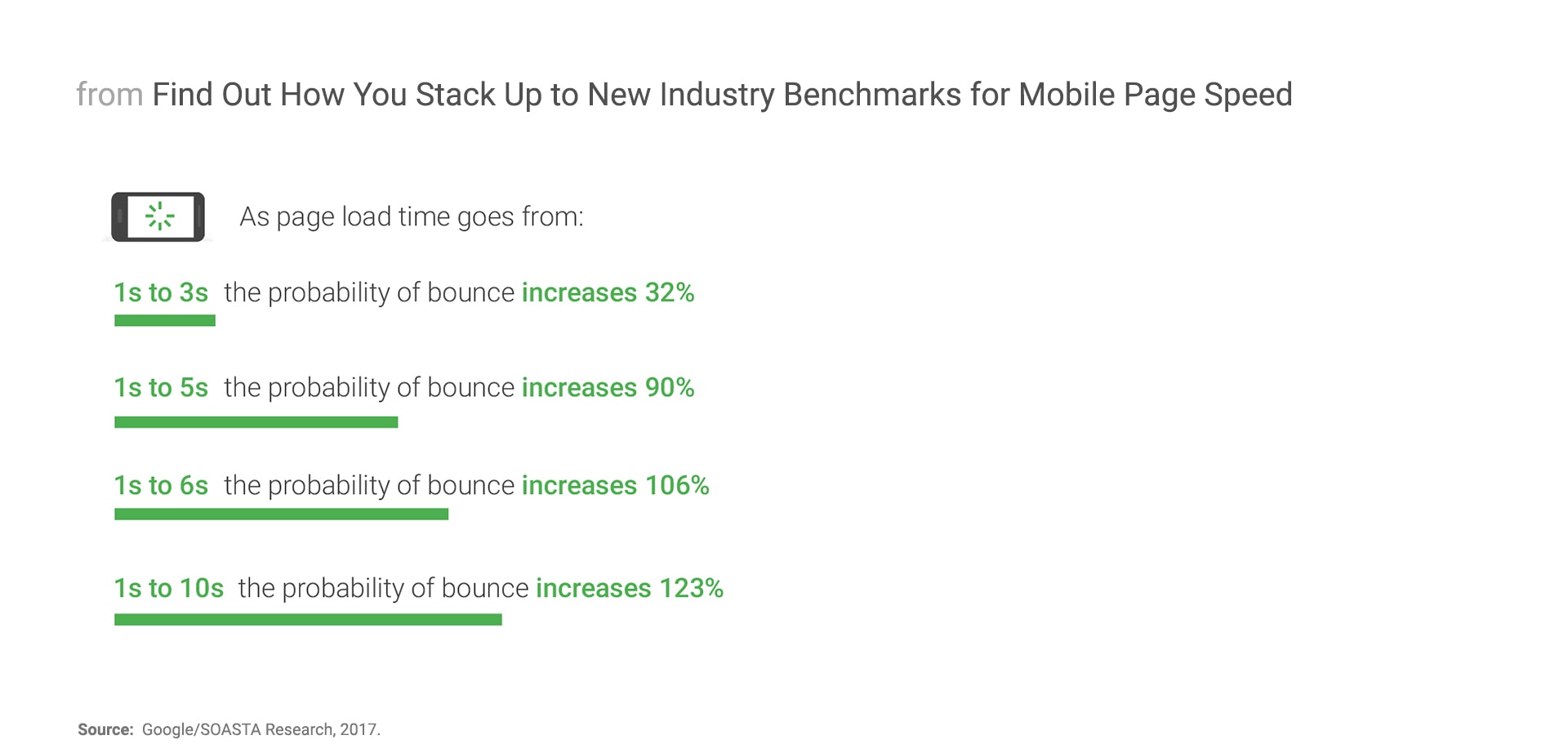
(Source)
Some quick tips to improve site speed include:
- Reduce your page size
- Only use images that are absolutely necessary
- Reduce the file size of your images
- Limit redirects
- Simplify your site’s code
There are many other things you can do to improve page load speed, but this shortlist is a good place to start.
Warning Sign #3: You Need More Repeat Customers
Your work doesn’t stop after someone buys from your online store. Your goal should be to bring as many customers as possible back to your store to make more purchases.
Getting someone to make a second purchase is tough, though—only 32% of first-time buyers will come back for a second purchase. However, once you get them to make that second purchase, they’re even more likely to make a third and a fourth from you.
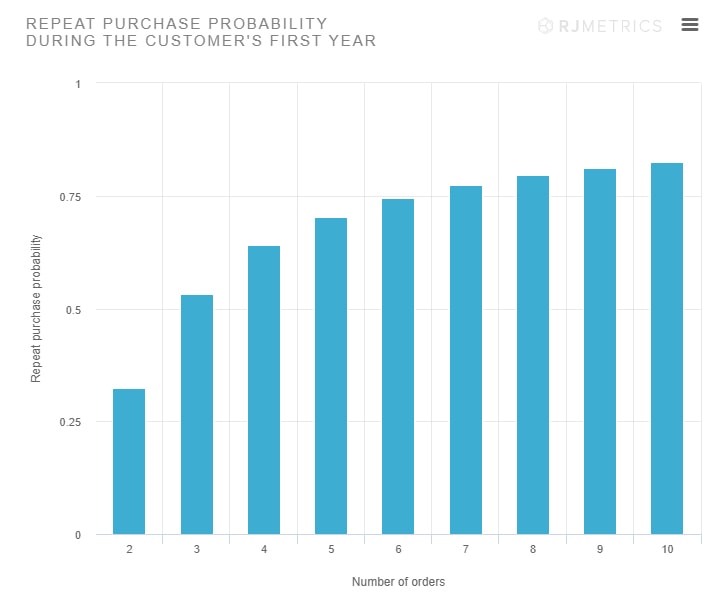
(Source)
So how can you retain more customers to keep them coming back for more? Let’s look at five specific tactics you can deploy.
5 Tips to Improve Customer Retention
1. Provide a simple, user-friendly shopping experience
Experience matters in ecommerce: A great experience will keep them around. In fact, data shows 86% of shoppers are willing to pay more for a great online shopping experience across devices.
Doing everything you can to make their user experience memorable will help bring them back for another purchase—from implementing a lightning fast checkout experience, to providing simple navigation and excellent communication post-sale.
2. Offer discounts and upsells post-purchase
You can make it easier for customers to come back for another purchase by showing them items that pair well with what they just purchased.
Post-purchase upsells can help boost your revenue by as much as 30%—without the risk of scaring someone off before they buy something.
After a purchase, you can also follow up with discount offers and sales based on their previous purchases to draw them back to your online store. It’s customer retention made simple.
3. Make receiving your products as exciting as buying them
Shipping products to your customers is the most personal touchpoint you’ll have with them. Does your packaging match your brand identity on your store? If it doesn’t, you’re missing out on a big opportunity to wow your customers and earn their loyalty.
One survey found that 45% of online shoppers think gift-like packaging makes a brand seem more luxurious. In the same survey, they learned that 62% of 18-29-year-olds would make a repeat purchase after receiving a surprise freebie item in their package.
The bottom line: Make your packaging feel like a truly exciting unboxing experience.
4. Reward loyalty
Creating a loyalty program “gamifies” shopping at your online store. It’s a simple way to bring people back and encourage them to continue shopping with you so they can reach the next level or earn the next reward.
You can offer incentives based on total spend or total purchases. Some great incentives include:
- Free shipping
- Loyalty discounts
- Early access to new products
- Store credit
5. Be social on social media
Social media isn’t just for showing off new products and telling people about your sales. It’s an opportunity to interact directly with your customers.
Liking and sharing posts where customers show off your products reinforces the personal connection between your customers and your ecommerce brand. That translates into 71% of people saying they’d recommend a company to their friends and families after having a positive experience on social media.
Make sure you’re truly being social on social media, though: It’s not a megaphone for your online store. Instead, think of it more like a cocktail party.
Online Store Optimization is a Long Journey, Not a Quick Task
Your work is cut out for you: You have to nurture your online store for it to continue growing.
Optimizing your online store will bring it up to the standard, but remember that ecommerce is quickly evolving. You can’t think of optimization as a one-time task that you check off your list and go back to counting profits.
You can’t think of optimization as a one-time task that you check off your list and go back to counting profits.
Instead, think of it as a process that requires consistent tweaking to make sure everything runs smoothly. Optimization is an opportunity to experiment with new copy, design, and tools that give your customers the best experience possible—from the first time they see you to after they become a loyal ambassador for your brand.



